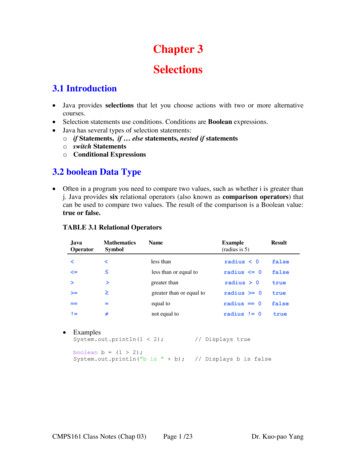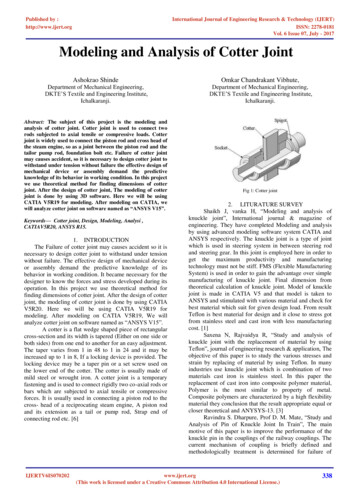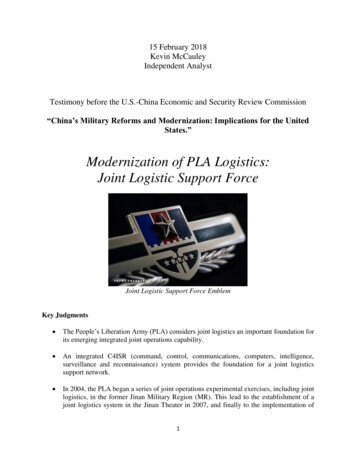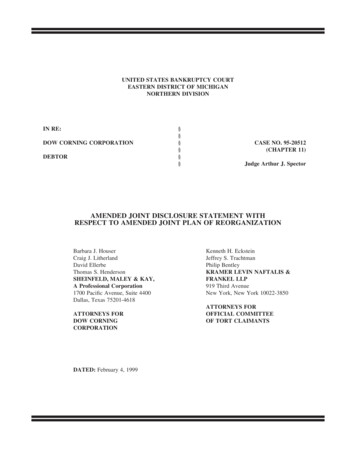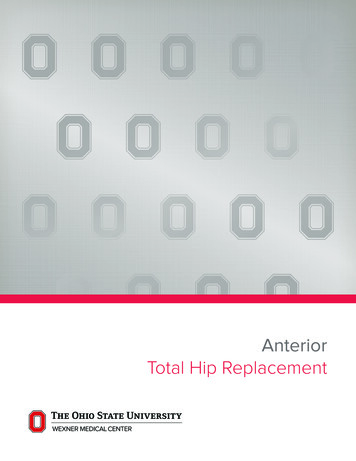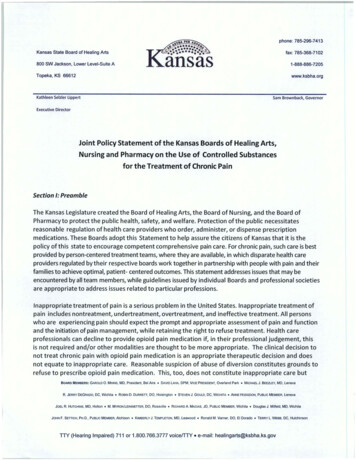
Transcription
phone: 785-296-7413Kansas State Board of Healing Artsfax: 785-368-7102800 SW Jackson, Lower Level-Suite A1-888-886-7205Topeka, KS 66612www.ksbha.orgKathleen Selzler LippertSam Brownback, GovernorExecutive DirectorJoint Policy Statement of the Kansas Boards of Healing Arts,Nursing and Pharmacy on the Use of Controlled Substancesfor the Treatment of Chronic PainSection 1: PreambleThe Kansas Legislature created the Board of Healing Arts, the Board of Nursing, and the Board ofPharmacy to protect the public health, safety, and welfare. Protection of the public necessitatesreasonable regulation of health care providers who order, administer, or dispense prescriptionmed ications. These Boards adopt this Statement to help assure the citizens of Kansas that it is thepolicy of this state to encourage competent comprehensive pain care . For chronic pain, such care is bestprovided by person-centered treatment teams, where they are available, in which disparate health careproviders regulated by their respective boards work together in partnership with people with pain and theirfamilies to achieve optimal, patient- centered outcomes. This statement addresses issues that may beencountered by all team members, while guidelines issued by individual Boards and professional societiesare appropriate to address issues related to particular professions.Inappropriate treatment of pain is a serious problem in the United States. Inappropriate treatment ofpain includes nontreatment, undertreatment, overtreatment, and ineffective treatment. All personswho are experiencing pain should expect the prompt and appropriate assessment of pain and functionand the initiation of pain management, while retaining the right to refuse treatment. Health careprofessionals can decline to provide opioid pain medication if, in their professional judgement, thisis not required and/or other modalities are thought to be more appropriate. The clinical decision tonot treat chronic pain with opioid pain medication is an appropriate therapeutic decision and doesnot equate to inappropriate care. Reasonable suspicion of abuse of diversion constitutes grounds torefuse to prescribe opioid pain medication. This, too, does not constitute inappropriate care butBOARD MEMBERS : GAROLD 0 . MINNS, MD, President, Bel Aire DAVID l.AHA, DPM, VICE PRESIDENT, Overland Pari MICHAEL J. BEEZLEY, MD, LenexaR. JERRY DEGRADO, DC, Wichita ROBIN D. DURRETT, DO, Hoisington STEVEN J. GoULD, DC, WICHITA ANNE HODGDON, PUBLIC MEMBER, LenexaJOEL R. HUTCHINS, MD, Holton M. MYRON LEINWETTER, DO, Rossville RICHARD A MACIAS, JD, PUBLIC MEMBER, Wichita Douglas J.M i el d ,MD, WichitaJOHN F. SETTICH, PH.D., PUBLIC MEMBER, Atchison KIMBERLY J. TEMPLETON, MD, Leawood Ronald M. Vamer, DO, El Dorado TERRY L. WEBB, DC, HutchinsonTTY (Hearing Impaired) 711 or 1.800.766.3777 voicefTTY e-mail: healingarts@ksbha.ks.gov
needs to be documented in the patient's medical record. Health care professionals who are notexperienced in the management of chronic pain may also decline to treat patients with thiscondition, if good faith attempts are made to refer patients to other providers with moreexperience.The experience of pain is always subjective, requiring that health care providers rely heavily on selfreported data in completing a pain assessment. The primary goal of pain management is to increasethe individual's level offunctioning to the greatest extent possible; functional improvement oftencorrelates with reduced pain, but these two outcomes may be unrelated in some individuals. Theexact goals of care and the treatment plan used to achieve those goals should be determined jointly bythe patient, family, and the health care team .The appropriate application of available treatment modalities in a manner supported by the bestavailable evidence improves the quality of life for people with pain and reduces the morbidity andcosts associated with inadequate or inappropriate pain care. All health care providers who treat peoplewith pain, whether acute or chronic, and regardless of cause, should be knowledgeable abouteffective methods of pain treatment and indications for appropriate referral to other health careproviders. The management of pain should include the use of both pharmacologic and nonpharmacologic modalities in an integrated biopsychosocial plan of care.Prescribing, dispensing, or administering controlled substances, including opioid analgesics, to treatpain and improve function is considered a legitimate medical purpose for the use of these medicationsif based upon a sound clinical evaluation and treatment plan. As in all other areas of health care, it isincumbent upon providers to recognize the risks and benefits inherent in providing pain care, and to seek tooptimize the risk-benefit ratio in formulating a plan of care. High-dose and/or long-term opioid therapy isassociated with an increased risk of various adverse outcomes, which may include physical complicationsand substance misuse, abuse, diversion, overdose, and death. Health care providers authorized by law toprescribe, administer or dispense medications, including controlled substances, should recognize therisks associated with this type of therapy and take appropriate action to minimize such risks. These providersshould be knowledgeable about the safe use of opioid analgesics; their role in an integrated, biopsychosocialtreatment plan; risk factors for adverse opioid-related outcomes and ways to screen for them; and the signsand symptoms of substance use disorders. They also should understand that tolerance and physicaldependence are normal consequences of sustained use of opioid analgesics and are not synonymouswith addiction.All boards have a duty to make an inquiry when they receive information contending that a licensedhealth care provider treated pain inappropriately. Proper investigation is necessary in order to obtainrelevant information. A health care provider should not construe any request for information as apresumption of misconduct. Prior to the filing of any allegations, the results of the investigation willbe evaluated by the health care provider's peers who are familiar with this and other relevant policystatements, as well as community standards of care. Health care providers who competently treatpain should not fear disciplinary action from their licensing boards.The following guidelines are not intended to define a standard of care or best practice, but rather tocommunicate what the boards consider to be within the boundaries of professional practice. This policystatement is not intended to interfere with any healthcare provider's professional duty to exercise that2
degree of learning and skill ordinarily possessed by competent members ofthat healthcare provider'sprofession.Section II: Principles for treating chronic painThe boards approve the following principles regarding health care professionals'responsibilities when evaluating the use of controlled substances for the treatment ofchronic pain:1. Assessment of the PatientPain and function should be assessed and reassessed as clinically indicated . Interdisciplinarycommunications regarding a patient's report of pain should include adoption of a standardizedprotocol for assessing pain. A complete pain assessment should evaluate not only the intensity of apatient's pain, but also the impact of that pain on the patient's physical, emotional, and socialfunctioning, as well as expectations for treatment outcomes. A number of standardized instrumentsare available to assist in this assessment, and clinicians should consider their use [REFS]. Assessmentalso should include evaluation of the individual's risk of substance misuse and abuse, ideally involvinguse of an evidence-based standardized instrument [REFS]. If controlled substances are, or may be,part of the individual's plan of care, obtaining a prescription monitoring program report and baselineurine/serum/saliva drug screen are strongly encouraged.2. Treatment PlanA written treatment plan should be strongly considered for all episodes of pain care. Such a plan shouldstate objectives that will be used to determine treatment success, such as pain relief and improvedphysical and psychosocial function, and should indicate if any further diagnostic evaluations ortreatments involving other health care professionals are planned . After treatment begins, thetreatment plan, especially the medication regimen, should be adjusted to the individual medical needsof each patient. The plan may include specific directions for adjusting medication doses or schedulesbetween evaluations by the prescriber. The plan may also include limiting the amount of opioid painmedication prescribed at a given time, with more frequent periodic reviews, to better assess potentiallyaberrant behavior. Other treatment modalities may be necessary, depending on the etiology of the painand the extent to which the pain is associated with physical and psychosocial impairment. If, in ahealthcare provider's sound professional judgment, pain should not be treated as requested by thepatient, the healthcare provider should discuss the basis for the treatment decisions with the patientand document the substance of this communication.3. Informed Consent and Agreement for Controlled Substance TreatmentEach patient should have one health care provider or provider team who primarily coordinates the paincare plan . That provider retains the ultimate responsibility for obtaining informed consent to treatmentfrom the patient. All health care providers share the role of effectively communicating with the patientso that he or she is apprised of the risks, benefits, side effects, and risk of addiction when usingcontrolled substances to treat pain.
If controlled substances are part of the individual's pain treatment plan, use of a written controlledsubstance treatment agreement should be strongly considered. The purposes of such an agreementare to ensure clarity on the part of both the patient and the health care provider regarding the roleof controlled substances in the overall treatment plan and to establish parameters governing theirprovision as part of a comprehensive treatment plan. Such an agreement should outline patientresponsibilities, including: Submitting to testing of medication levels when requested; Limiting prescription refills only to a specified number and frequency; Requesting and receiving prescription orders from only specified health care providers; Using only one pharmacy or pharmacy chain for filling prescriptions; Storing medications securely, not sharing them with anyone else, using them only as directed, anddisposing of excess supplies in a safe and effective manner; and Acknowledging reasons for which the drug therapy may be modified or discontinued (e.g .,violation of agreement).4. Periodic ReviewAt reasonable intervals based on the individual circumstances of the patient, the course oftreatment and new information about the etiology of the pain should be evaluated. Communicationamong healthcare providers is an essential part of reviewing the plan of care. The health care providersinvolved in providing pain care should evaluate progress toward meeting treatment objectives in termsof physical and psychosocial outcomes (e.g., ability to work or attend school; emotional, cognitive, andbehavioral functioning; need for health care resources; activities of daily living; and quality of social life).Such periodic reviews should include an evaluation ofthe patient's current prescription monitoringprogram report, assessing for the presence of aberrant behaviors, determining safe function at homeand at work while taking opioid medication, testing for medication levels, pill counts, and othermonitoring techniques, at a frequency determined by the health care provider based on the patient'sevaluated risk for substance misuse, abuse, and/or diversion.If treatment goals are not being achieved despite medication adjustments and the use of othertreatment modalities, the health care providers should reevaluate the diagnosis, the impact of nonopioid treatment modalities, and the appropriateness of continued controlled substance treatment. Ifit is determined that controlled substances are not providing expected benefits and/or are causingadverse outcomes, their doses should be tapered and/or discontinued, in a manner that minimizes therisk of producing withdrawal and appropriately treats any emerging symptoms of withdrawal. Otherchanges to the treatment plan, as indicated by the results of the evaluation, should be made asneeded.s. ConsultationThe health care provider should be willing to refer the patient as necessary for additional evaluationand treatment in order to achieve treatment objectives. Special attention should be given to thosepatients with co-morbid psychiatric disorders and those who are at risk for misuse or diversion oftheirmedications. The management of pain in patients with a history of substance abuse or with a co-morbidpsychiatric disorder can be challenging, and extra care, monitoring, documentation, and consultation4
with or referral to an expert(s) in the management of such patients may be appropriate. In addition,many patients with chronic pain may benefit from referral to providers with other areas of expertise,to develop a multimodality approach to pain control.If there is reasonable suspicion based upon aberrant behavior, such as seeking refills earlier orfrequent loss of medications or prescriptions, that patients are misusing or diverting controlledsubstances, the health care provider can refuse further treatment or make a good faith effort to referthe patient to another provider. These episodes of aberrant behavior and the rationale for refusing ortransferring care need to be documented in the patient's medical record.6. Medical RecordsThe medical record should document the results of the pain and functional assessments and containpertinent information concerning the patient's health history, including previous treatment for pain orother underlying or coexisting conditions. The medical record also should document the presence ofone or more recognized medical indications for the use of a controlled substance.The results of periodic reviews should be documented to assist in evaluating the patient's progresstoward the goals set out in the plan of care. These reviews may include findings from the patient examinationthe prescription monitoring program reportdrug testing resultsresults of consultations with, or treatments provided by, other health care providersIf a patient is not progressing as anticipated and the health care provider is contemplating changingdosages or medications, the rationale for these changes should be documented in the patient'smedical record, along with an anticipated timeline for follow-up to assess the efficacy of the newtreatment regimen.7. Compliance with Controlled Substances Laws and RegulationsTo prescribe, dispense or administer controlled substances within this state, the health care providermust be licensed according to the laws of this state and comply with applicablefederal and state laws.Section Ill: Principles for treating acute pain[To be added]Section IV: DefinitionsFor the purposes of these guidelines, these terms are defined as follows:5
Aberrant behaviors associated with opioid medication drug abuse may include selling medications;obtaining medications from non-medical sources; forgery or alteration of prescriptions; injectingmedications intended for oral use; resistance to changing medications despite deteriorating functionor significant negative effects; recurrent episodes of prescription loss or theft; repeated violations ofpain agreements; independently increasing dosing; repeatedly running short of medications andrequesting early refills. Providers should be aware that some behaviors may initially appear to beaberrant, but may actually be part of the normal process of stabilizing a patient's pain condition.Acute pain is the normal, predictable physiological response to a noxious chemical, thermal ormechanical stimulus and is associated with invasive procedures, trauma and acute illness. Itis generally time-limited, and resolves as the identified cause resolves.Addiction is a neuro-behavioral syndrome with genetic and environmental influences that results inpsychological dependence on the use of substances for their psychic effects and is characterized bycompulsive use despite harm. Addiction may also be referred to as "psychological dependence."Physical dependence and tolerance are normal physiological consequences of extended opioidtherapy for pain and should not be considered addiction. Addiction must be distinguished frompseudoaddiction, which is a pattern of drug-seeking behavior of pain patients who are receivinginadequate pain management that can be mistaken for addiction.Analgesic tolerance is the need to increase the dose of opioid to achieve the same level of analgesia.Analgesic tolerance may or may not be evident during opioid treatment and does not equate withaddictionChronic pain is a state in which pain persists beyond the usual course of an acute disease or healingof an injury. It may or may not be associated with an acute or chronic pathologic process thatcauses continuous or intermittent pain over a period of months or years.Diversion is defined as the intentional transfer of a controlled substance from authorized tounauthorized possession or channels of distribution.Misuse (also called nonmedical use) encompasses all uses of a prescription medication other thanthose that are directed by a health care provider and used by a patient within the law and therequirements of good medical practice.Opioid is any compound that binds to an opioid receptor in the central nervous system. The classincludes both naturally-occurring and synthetic or semi-synthetic opioid drugs or medications, aswell as endogenous opioid peptides.Pain is an unpleasant sensory and emotional experience associated with actual or potential tissuedamage or described in terms of such damage.Physical dependence on a controlled substance is a state of biologic adaptation that is evidencedby a class-specific withdrawal syndrome when the drug is abruptly discontinued or the doserapidly reduced, and/or by the administration of an antagonist. Physical dependence is an6
expected result of extended opioid use. Physical dependence, by itself, does not equate withaddiction.Prescription Monitoring Program is a state-operated program that facilitates the collection, analysis,and reporting of information on the prescribing and dispensing of controlled substances. The KansasTracking and Reporting of Controlled Substances (K-TRACS) program employs electronic data transfersystems, under which prescription information is transmitted from the dispensing pharmacy to theKansas Board of Pharmacy, which collates and analyzes the information, and makes it available toauthorized parties.Substance abuse is the use of any substance(s) for non-therapeutic purposes or use ofmedication for purposes other than those for which it is prescribed.Tolerance is a state of physiologic adaptation in which exposure to a drug induces changes that resultin diminution of one or more of the drug's effects over time. Tolerance is common in opioid treatment,has been demonstrated following a single dose of opioids, and is not the same as addiction.APPROVALSThe foregoing Joint Policy Statement was approved, upon a motion duly made, seconded and adoptedby a majority of the Kansas Board of Healing Arts, on the 12th day of August, 2016.The foregoing Joint Policy Statement was approved, u motion uly made, seconded and adoptedby a majority ofthe Kansas Board of Nursing on the Iday of :5o.p :J-/J4y! tPL.) ,The foregoing Joint Policy Statement was approved, upon a motion duly made, seconded and adoptedby a majority of the Kansas Board of Pharmacy on the day of 1/)rJ tl 1.-r"" , 20 .! f .7
Kansas State Board of Healing Arts fax: 785-368-7102 800 SW Jackson, Lower Level-Suite A 1-888-886-7205 Topeka, KS 66612 www.ksbha.org Kathleen Selzler Lippert Sam Brownback, Governor Executive Director Joint Policy Statement of the Kansas Boards of Healing Arts, Nursing and Pharmacy on the Use of Controlled Substances



